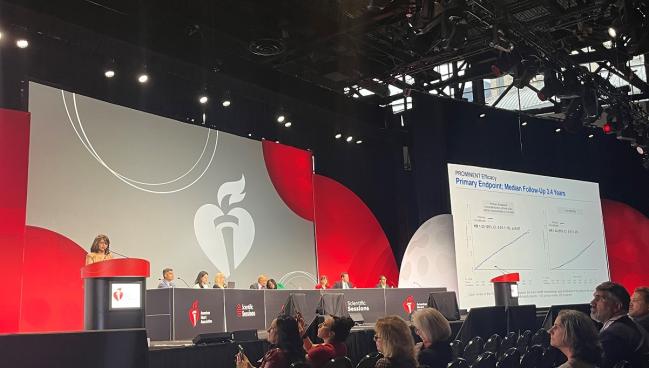Pemafibrate Fails to Lower CVD Risk in Patients With High Triglycerides: PROMINENT
The disappointing results are a blow to the triglyceride hypothesis: leading experts offer their take on what’s next.

CHICAGO, IL—Pemafibrate (Parmodia; Kowa Pharmaceuticals) has disappointingly missed the mark in a large randomized, clinical trial testing the agent in type 2 diabetic patients with mild-to-moderate hypertriglyceridemia and low HDL-cholesterol levels.
After a median follow-up of 3.4 years, the peroxisome proliferator-activated receptor alpha (PPARα) agonist failed to lower the risk of nonfatal MI, ischemic stroke, coronary revascularization, or death from cardiovascular causes when compared against placebo, with no benefit observed in any of the prespecified subgroups, report investigators.
Aruna Das Pradhan, MD, MPH, MSc (Brigham and Women’s Hospital, Boston, MA), who led the PROMINENT study, said that when patients with mild-to-moderate hypertriglyceridemia are treated with a high-intensity statin, “these data really question the practice of adding additional therapy just to target triglycerides, at least with this strategy.”
Targeting high plasma triglycerides as a potential way to reduce the risk of atherosclerotic cardiovascular disease (ASCVD) is controversial at the current moment, she added.
There have been two randomized trials testing different purified omega-3 fatty acid formulations to reduce hard clinical outcomes in patients with high triglycerides—REDUCE-IT and STRENGTH—and each showed different results. While REDUCE-IT with icosapent ethyl (Vascepa; Amarin) was positive, critics, including investigators from the neutral STRENGTH study, have questioned whether it might not be a “false-positive” finding. Right now, only icosapent ethyl has an indication from the US Food and Drug Administration to reduce ASCVD events in this population.
With pemafibrate, Pradhan said “they’d hoped to have another option” to treat patients with elevated triglyceride levels, noting this group remains a common and perplexing challenge for clinicians. Patients with mild-to-moderate hypertriglyceridemia are at an elevated risk of an ASCVD event, so most physicians “want to do something to reduce triglyceride levels,” she said.
Howard Weintraub, MD (NYU Langone Medical Center, New York, NY), who wasn’t involved in the study, also said there had been hope that PROMINENT would be positive.
“People want triglycerides to be a culprit,” he told TCTMD. “They want them to be responsible for atherosclerosis, and the paradigm for proving that would be to show that when you lower them, cardiovascular risk goes down. A lot of trials were criticized because they didn’t enroll the right kind of patients, but this one did. They should be congratulated.”
Targeting the LPL Pathway
Pemafibrate is a novel fibrate that lowers triglyceride levels by suppressing secretion from the liver and increasing lipoprotein lipase (LPL) activity to catabolize triglyceride-rich lipoproteins. It also stimulates HDL-cholesterol production in the liver and increased cholesterol efflux from macrophages.
The PROMINENT study, presented today as a late-breaking clinical trial at the American Heart Association 2022 Scientific Sessions and published simultaneously in the New England Journal of Medicine, included 10,497 patients (mean age 64 years; 27.5% women) with type 2 diabetes, mild-to-moderate hypertriglyceridemia (fasting 200 to 499 mg/dL), and low HDL-cholesterol levels (< 40 mg/dL). The primary-prevention cohort, which made up 33.1% of the overall population, included men and women 50 and 55 years and older, respectively, while the secondary-prevention group included all adults 18 years and older with ASCVD.
More than 95% of patients were treated with statins, including 69% who received high-intensity statin therapy, and 80% were treated with an ACE inhibitor or ARB. Approximately 9.0% were prescribed a glucagon-like peptide-1 (GLP-1) analogue, and roughly 17% were treated with a sodium glucose cotransporter-2 (SGLT2) inhibitor. The median triglyceride, HDL cholesterol, and LDL-cholesterol levels at baseline were 271 mg/dL, 33 mg/dL, and 78 mg/dL, respectively. The median non-HDL-cholesterol level was 128 mg/dL.
People want triglycerides to be a culprit. Howard Weintraub
At 4 months, treatment with pemafibrate lowered triglyceride levels by 26.2% compared with placebo. Additionally, very-low-density lipoprotein (VLDL) cholesterol was reduced by 25.8%, with similar reductions seen in remnant cholesterol and apolipoprotein C-III (apoC-III). In contrast, apolipoprotein B (apoB) levels increased 4.8% as did LDL cholesterol.
The primary endpoint occurred in 572 patients treated with pemafibrate and 560 patients treated with placebo (HR 1.03; 95% CI 0.91-1.15), with no effect seen in any of the individual endpoints. The risk of any serious adverse event was similar between the two groups, but there was a higher risk of venous thromboembolism and pulmonary embolism with pemafibrate. There was also a higher risk of any adverse renal events, but pemafibrate was associated with a significant reduction in any liver disease and nonalcoholic fatty liver disease.
Hepatic outcomes, said Pradhan, are an important consideration in this patient population and the drug’s beneficial effect here needs to be validated and studied further.
Regarding the changes in biomarkers, Pradhan said the drug appears to effectively target the LPL pathway, noting that remnant cholesterol levels were decreased, which is the cholesterol transported in triglyceride-rich lipoproteins after lipolysis and lipoprotein remodeling. The tradeoff is that plasma LDL cholesterol, cholesterol, and apoB levels increased, which “may be the direct result of a conversion of triglycerides,” she said.
Lining Up With STRENGTH
The PROMINENT researchers say their neutral results are consistent with STRENGTH, as well as other clinical trials testing niacin and fenofibrate in patients with high triglyceride levels. For example, extended-release niacin in the AIM-HIGH study didn’t lower the risk of major cardiovascular events in ASCVD patients with low HDL cholesterol and high triglyceride levels. The FIELD and ACCORD trials with fenofibrate, both of which enrolled patients with high triglyceride levels, were also negative.
Senior investigator Paul Ridker, MD (Brigham and Women’s Hospital), said that subgroup analyses of prior fibrate trials, including ACCORD and FIELD, hinted at a benefit in terms of ASCVD-event reduction in patients with high triglycerides and low HDL-cholesterol levels, which is the population they specifically targeted in PROMINENT.
“That’s why we did this trial,” Ridker told TCTMD. “We were very optimistic this was a terrific drug that turns out to be very safe. Were we misled by these subgroup analyses done a decade ago? It’s possible. It’s also possible that life has just changed. This is a trial [of patients] on high-intensity statins. They were just not used in that prior period.”
Were we misled by these subgroup analyses done a decade ago? It’s possible. It’s also possible that life has just changed. Paul Ridker
For clinicians, said Weintraub, the big question is what to do now with a patient with ASCVD who has elevated triglycerides (200 to 500 mg/dL). For Weintraub, the best approach is guideline-recommended therapy and lifestyle changes.
“What I think doctors should be doing is making sure they optimize LDL lowering—statins, and if needed, PCSK9 inhibitors—and also recognizing that triglycerides are associated with diet and obesity and glucose problems,” he said. “This is something that really calls for lifestyle modification, which is diet and exercise, as both have a favorable impact.”
Avoiding alcohol and refined carbohydrates and sugars is key, he said. If that fails, and triglycerides are still too high, then he would prescribe icosapent ethyl because it’s the sole triglyceride-lowering agent that reduces major adverse cardiovascular events. Although fibrates shouldn’t be used with the expectation they’ll reduce ASCVD events, he would use them to lower triglycerides.
“I wouldn’t be eager to do it,” said Weintraub. “We recognize we might not be lowering atherosclerotic risk, but we may be doing something for pancreatitis risk, and I firmly believe that you certainly won’t be hurting them from a cardiac perspective.”
In an editorial, Salim Virani, MD (Baylor College of Medicine/Michael DeBakey VA Medical Center, Houston, TX), also said that fibrates should not be used to reduce the risk of ASCVD in statin-treated patients, but they “may have a role to play in decreasing the risk of pancreatitis associated with severe hypertriglyceridemia and perhaps nonalcoholic fatty liver disease.”
Other Avenues to Explore Still
Pradhan pointed to other potential drugs and therapeutics in development for lowering triglyceride levels, specifically those targeting APOC3 and ANGPTL3, genetic targets that are known to regulate triglyceride levels. There are several therapies in the works, including an antisense oligonucleotide targeting APOC3 mRNA and small-interfering RNA therapies targeting APOC3 and ANGPTL3.
“I would not close the book just yet” on the triglyceride-lowering hypothesis, said Pradhan.
Stephen Nicholls, MBBS, PhD (Monash University, Melbourne, Australia), who led the STRENGTH study, called the PROMINENT results “interesting, sobering,” and noted that the Kaplan-Meier event curves in the trial were virtually superimposable, just as they were in STRENGTH. As to why pemafibrate failed, Nicholls pointed to the apoB levels that rose slightly with active treatment.
“The lack of any apoB reduction is critical and reaffirms the data from genetic studies that suggest that if targeting factors involved in [lipoprotein lipase] metabolism are to produce a cardiovascular benefit, it is proportional to apoB lowering,” he told TCTMD. “The authors cite a lack of benefit in numerous trials, with the outlier being REDUCE-IT. This continues to suggest we need more trials in both the cardiovascular and omega-3 fatty acid areas.”
The liver data, he added, may give it another shot in clinical development.
Michael Miller, MD (Penn Medicine/Corporal Michael Crescenz VA Medical Center, Philadelphia, PA), made a similar comment, noting that hypertriglyceridemia is highly atherogenic largely because of excessive levels of apoB-containing particles. In REDUCE-IT, icosapent ethyl reduced apoB and non-HDL-cholesterol levels, but these were not reduced in the negative STRENGTH and PROMINENT studies.
“The mechanism for CVD benefit appears to be the combined reduction in VLDL/apoB production and enhanced degradation of triglyceride-rich atherogenic particles,” Miller told TCTMD via email. “Eicosapentaenoic acid does both whereas fibrates enhance lipolyses of triglyceride-rich particles but are much less effective in reducing hepatic VLDL synthesis.”
To TCTMD, Ridker said it’s reasonable to think that therapies will need to reduce apoB to have an impact on ASCVD events. He noted that some of the novel therapies in development—those targeting APOC3 and ANGPTL3—shouldn’t increase apoB levels, however. The end result is that it’s actually quite complicated to impact ASCVD outcomes by targeting elevated triglyceride levels, said Ridker.
Michael O’Riordan is the Managing Editor for TCTMD. He completed his undergraduate degrees at Queen’s University in Kingston, ON, and…
Read Full BioSources
Pradhan AD, Glynn RJ, Fruchart J-C, et al. Triglyceride lowering with pemafibrate to reduce cardiovascular risk. N Engl J Med. 2022;Epub ahead of print.
Virani SS. The fibrates story—the tepid end to a PROMINENT drug. N Engl J Med. 2022;Epub ahead of print.
Disclosures
- Pradhan reports grant support from Denka and Kowa Pharmaceuticals and consulting for Reliant Medical Group, Novo Nordisk, and the National Association for Continuing Education.
- Virani reports grant support from the Department of Veteran Affairs, NIH, World Heart Foundation, and the Tahir and Jooma Family. He reports personal fees from the American College of Cardiology, American Society of Preventive Cardiology, National Lipid Association, Practice Updates in Primary Care, and the Continuing Education Company.





Comments